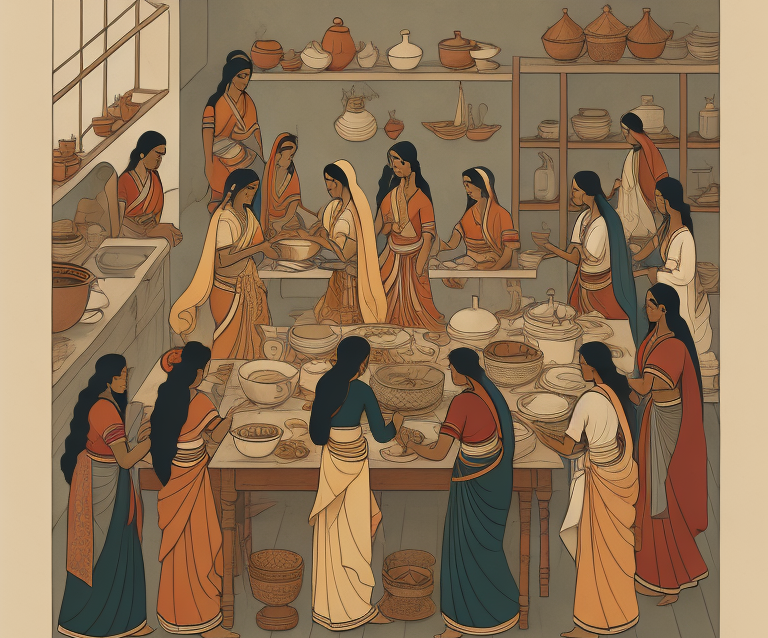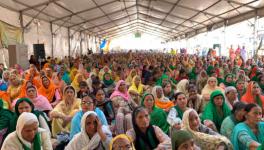History Myth Busting Series - IV: Women in Vedic Society

Image for representational purpose.
In the past few years, many debates and contentions about history have moved from the academic sphere and entered a wider public forum. A battleground has emerged where particular cultures, narratives and ideologies are pitted against others in order to prove one as dominant and superior to others. The Hindu Right is a major proponent of many such false narratives which aim to establish a particular version of Hindu culture and ideology as the sole and rightful heir to India’s varied history and culture. Such false narratives abandon what the academic world has established through evidence, and they rely on getting traction through popular media, including social media. NewsClick is publishing a series of brief explainers based on evidence-based scholarly research that counters some of these prominent myths propagated by Hindutva forces. Parts 1, 2, and 3 of this series can be read here, here, and here respectively.
Certain narratives are being propagated today that claim that an exalted status was enjoyed by women during the Vedic period. They often project it as a ‘golden era’ in terms of women’s rights, status and role in society. Krishna Gopal, a senior RSS leader, has gone so far as to say that “The women in Vedic times enjoyed equal status, it was only after Islamic invasion that their condition deteriorated”. This brings us to the second part of this narrative. Once the Vedic age is called the golden age for women, the next step is to explain the deterioration of women’s lives as seen today. This is done by primarily blaming subsequent ‘invaders’ such as the Mughals for damaging the position of women. To assess these claims, it becomes necessary to study the actual experiences of women during the Vedic and subsequent periods.
The main sources that are referred to in order to gain a sense of women’s status during the ancient period are various Brahmanical texts, ranging from the Rigveda to epics like the Mahabharat and the Smritis such as the Manusmriti. First, it should be noted that the history that can be derived from them is limited. In the case of more didactic and instructional texts, historians have to take into account the fact that these texts were written by male brahman authors. Thus, the content of the texts pertains mostly to the interests of male brahmans and how they believe various elements of society should function. This limits the kind of histories of women that can be derived from these sources. Even if a particular history can be derived, one should also question whether it represents women entirely or a particular stratum of women. In the case of epics such as the Mahabharata, it has to be understood that these are exceptional stories of exceptional characters. Thus, if a prominent woman character is shown as having an important decision-making role, we cannot judge it as being the general case for all women. These characters are the exceptions rather than the norm and that’s what makes them compelling within the story.
Women are exclusively conceptualised in the context of their family within these sources. This means that they are thought of as only being daughters, mothers, and wives. It is argued by the RSS that within these roles, women found great respect and status. Some even claim that wives enjoyed more rights than their husbands. While others state that a man was taught to treat all women (except his wife) as he would his mother and that every girl should be treated as if she’s their own daughter. Thus, it needs to be understood exactly how daughters, mothers, and wives were treated by society as described by the sources.
In the case of daughters within Vedic society, we see consistent themes of them being undesirable, being seen as burdens, and sons being preferred over them. An excerpt from the Aitareya Brahmana, “sakhã ha jãyã krpanam ha duhitã jyotir ha putrah parame vyoman” is translated as “a wife is a comrade, a daughter a misery, and a son a light in the highest heaven”. This clearly establishes the daughter as a source of misery, whereas the son is possibly the saviour of the entire family. Within the Atharvaveda, we see a clear desire to protect the pregnant woman from demons who would force the male child into becoming a female instead. An instance is the expression “mã pumãmsam striyam kran”, in other words “let them not make the male female”. Daughters could also be treated as objects. Uma Chakravarti, an eminent historian, points this out in her article when she states that “Even princesses were dealt as property by their royal fathers. King Jánašruti Pautrãyana gave his beautiful daughter to the low caste poor Raikva in exchange of his desired knowledge”.
Constraints continued to be imposed on women throughout the various stages of their lives as daughters, wives, and mothers. According to the Manusmriti, nothing must be done independently by women, even within their household. Further, it clearly outlines to whom a woman is always subservient to throughout her life: “In childhood, a female must be subject to her father, in youth to her husband, when her lord is dead to her sons; a woman must never be independent”. The kind and amount of property that a woman could own was limited as well. The texts do not mention the ability to possess property being available to unmarried women. Instead, only married women could possess a limited property known as stridhan, which was given to her at the time of marriage. However, she lacked complete control over even this property as it ultimately belonged to her husband.
In terms of the ritual roles that women could take on, the daughters, sisters, or mothers had none assigned to them. While the wife was regarded as a critical resource due to her reproductive abilities, she was used more as a ritual object in order to ensure the birth of children. Women sages are mentioned rarely as well. A popular instance of a woman sage is that of Gargi Vachaknai, who questioned Yajnavalkya during a debate. This is often cited as an example of women having access to education as well as the ability to actively question and learn from the Brahmans. However, in the story itself, Yajnavalkya suppresses Gargi when her questions become difficult to answer. He says that “Do not, O Gargi, push your enquiry too far, lest your head should fall off”. This results in Gargi going silent. Clearly, her questioning was something that was not entirely welcome. No matter how you might interpret Yajnavalkya’s statement, its condescending and even threatening nature is quite evident.
One thing to take note of here is that much of the texts that we have concerning the experiences of women are limited to telling stories about upper caste and class women such as Gargi or King Jánašruti Pautrãyana’s daughter. There would have been a great difference in the way women from various castes and classes would have experienced oppression. In the cases of women belonging to the lower castes, their oppression would have been double. This intersectionality of caste, class, and gender has to be kept in mind. Not all forms of oppression would have been uniform across the various castes and classes, some would have remained exclusive to a certain group.
In order to get a better sense of what women of this time period experienced and felt, historians look at alternative sources such as the Therigatha. This is a collection of songs composed by Buddhist theris or senior nuns and was committed to writing around 80 BCE. Uma Chakravarti and Kumkum Roy have provided translations of some of these songs in the first volume of Women Writing in India. Mutta, a Buddhist nun sings:
“So free am I, so gloriously free,
Free from three petty things –
From mortar, from pestle and from my twisted lord,
Freed from rebirth and death I am,
And all that has held me down
Is hurled away.”
Another nun, Sumangalamata, sings a similar tune:
“A woman well set free! How free I am,
How wonderfully free, from kitchen drudgery.
Free from the harsh grip of hunger and from empty cooking pots,
Free too of that unscrupulous man,
The weaver of sunshades”.
These are songs of celebration, in which the nuns are rejoicing the fact that they now have seemingly better lives due to their conversion to Buddhism and escape from the constraints imposed by society.
One final element of the RSS narrative that has to be addressed is the blaming of later “invaders” for the desecration of women’s status and roles in society. The Mughals are their preferred scapegoats. It has already been established that the period before Mughal rule was not one of equality and exalted status of women. They faced countless injustices and forms of discrimination which would have continued into the Mughal period as well. We know that Sati continued under Mughal rule and the purdah system became prevalent, especially among the upper classes and castes. However, one cannot ignore that the Mughals made attempts to improve the lives of women by introducing laws to prevent forceful sati within their kingdoms. Akbar issued an edict banning forced sati and he also appointed officials in every city who would review different cases of sati being practised. At times, Akbar personally interfered in certain cases as well. Jahangir went on to prohibit sati and infanticide as well. He also prescribed punishments for the same. While sati did ultimately continue as a practice, the frequency and number of instances would have declined. As we can see, the position of women has been a historically oppressed one throughout Indian societies. It is only during contemporary times that we can even come close to making claims of women having a better status within society.
This attempt to prove a much earlier period of time as being ‘better’ for women, as a time when they would’ve enjoyed an equal or even greater status as compared to their male counterparts is one that disregards the feminist movement entirely. By making such claims, the centuries of hardships faced by women during their attempts to establish their voices is ignored. The progress that has been made so far is deemed as something that was already there in the ancient past but clearly, that was not the case. Progress still needs to be made in terms of women’s rights, status, and roles within modern society. It will certainly not be made if we hark back to false narratives instead of working towards concrete progress.
The writer is an intern with NewsClick. The views are personal.
Get the latest reports & analysis with people's perspective on Protests, movements & deep analytical videos, discussions of the current affairs in your Telegram app. Subscribe to NewsClick's Telegram channel & get Real-Time updates on stories, as they get published on our website.
















